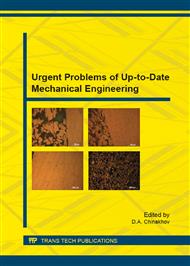[1]
Newell P. Paterson M., 2011, Climat et cahitalism, 23-44.
Google Scholar
[2]
Galieger X. N. , Barysheva G. A. , Artser T. V. Development of public- private parnership in the field of environment and natural resources / 8th International Forum on Strategic Technology (IFOST - 2013): Proceedings: in 2 vol., Ulanbaatar, 28 June-1 July 2013. - Ulanbaatar: MUST, 2013 - Vol. 2 - pp.787-789.
Google Scholar
[3]
Knetsch, J.L., 2007. Biased valuations, damage assessments, and policy choices: the choice of measure matters. Ecol. Econ. 63 (4), 684–689.
DOI: 10.1016/j.ecolecon.2007.02.012
Google Scholar
[4]
Zafonte, M.C., Hampton, S., 2007. Exploring welfare implications of resource equivalency analysis in natural resource damage assessments. Ecol. Econ. 61 (1), 134–145.
DOI: 10.1016/j.ecolecon.2006.02.009
Google Scholar
[5]
Moilanen, A., van Teeffelen, A.J.A., Ben-Haim, T., Ferrier, S., 2009. How much compensation is enough? A framework for incorporating uncertainty and time discounting when calculating offset ratios for impacted habitat. Restor. Ecol. 17 (4), 470–478.
DOI: 10.1111/j.1526-100x.2008.00382.x
Google Scholar
[6]
Bendor, T., 2009. A dynamic analysis of the wetland mitigation process and its effects on no net loss policy. Landsc. Urban Plan. 89 (1–2), 17–27.
DOI: 10.1016/j.landurbplan.2008.09.003
Google Scholar
[7]
Howden, S.M., Soussana, J.F., Tubiello, F.N., Chhetri, N., Dunlop, M., Meinke, H., 2007. Adapting agriculture to climate change. Proceedings of the National Academy of Sciences of the United States of America 104, 19691–19696. Towards Environmental Innovation Systems. Springer Verlag, Berlin. Environment and Planning A 40, 867–884.
DOI: 10.1073/pnas.0701890104
Google Scholar
[8]
Reed, M.S., 2008. Stakeholder participation for environmental management: a literature review. Biological Conservation 141, 2417–2431.
DOI: 10.1016/j.biocon.2008.07.014
Google Scholar
[9]
Kern, F., Smith, A., 2007. Restructuring energy systems for sustainability? Energy transition policy in the Netherlands. SPRU, University of Sussex, Brighton, UK, Sussex Energy Working Paper.
Google Scholar
[10]
Stringer, L.C., Reed, M.S., Dougill, A.J., Twyman, C., 2009. Local adaptations to climate change, drought and desertification: insights to enhance policy in southern Africa. Environmental Science & Policy 12, 748–765.
DOI: 10.1016/j.envsci.2009.04.002
Google Scholar
[11]
McGuire, S.J., Sperling, L., 2008. Leveraging farmers' strategies for coping with stress: seed aid in Ethiopia. Global Environmental Change — Human and Policy Dimensions 18, 679–688.
DOI: 10.1016/j.gloenvcha.2008.07.002
Google Scholar
[12]
Ostrom, E., Burger, J., Field, C., Norgaard, R., Policansky, D., 1999. Revisiting the commons: local lessons. Global Challenges Science 284, 278–282.
DOI: 10.1126/science.284.5412.278
Google Scholar
[13]
Foxon, T., Reed, M.S., Stringer, L.C., 2009. Governing long-term socio-ecological change: what can resilience and transitions approaches learn from each other? Environmental Governance & Policy 19, 3–20.
DOI: 10.1002/eet.496
Google Scholar
[14]
Pelling, M., High, C., Dearing, J., Smith, J., 2008. Shadow spaces for social learning — a relational understanding of adaptive capacity to climate change within organizations.
DOI: 10.1068/a39148
Google Scholar
[15]
Turner, R.K., Daily, G.C., 2008. The ecosystem services framework and natural capital conservation. Environmental and Resource Economics 39, 25–35.
DOI: 10.1007/s10640-007-9176-6
Google Scholar
[16]
Small, L.A., 2007. The sustainable rural livelihoods approach: a critical review. Canadian Journal of Development Studies 28, 27–38.
Google Scholar
[17]
Bruggeman, D.J., Jones, M.L., Lupi, F., Scribner, K.T., 2005. Landscape equivalency analysis: methodology for estimating spatially explicit biodiversity credits. Environ. Manag. 36 (4), 518–534.
DOI: 10.1007/s00267-004-0239-y
Google Scholar
[18]
Smit, B., Wandel, J., 2006. Adaptation, adaptive capacity and vulnerability. Global Environmental Change — Human and Policy Dimensions 16, 282–292.
DOI: 10.1016/j.gloenvcha.2006.03.008
Google Scholar


